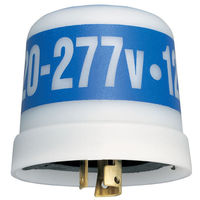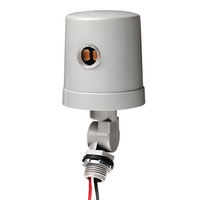Photocells & Photo Control Switches
- FILTERS:
- Brand : Intermatic
- Voltage : 277
- RESET
Electronic Photocontrol - Standard Grade Locking Type Mount
LED Compatible - 5,000 Life Hour - 120-277 Volt - Intermatic ELC4536
- Life Expectancy: 10 Years
- Height: 2.2 in.
- Diameter: 3.18 in.
- Case Quantity: 12



Electronic Photocontrol - Select Grade Locking Type Mount
LED Compatible - 10,000 Life Hour - 120-277 Volt - Intermatic EK4536
- Life Expectancy: 15 Years
- Height: 2.72 in.
- Diameter: 2.97 in.
- Case Quantity: 6


Electronic Button Type Photocell - Fixed Position Mounting
LED Compatible - Dusk-to-Dawn - 120-277 Volt - Intermatic EK4036S
- Length: 2.25 in.
- Width: 1.3 in.
- Depth: 1.24 in.
- Case Quantity: 12




Electronic Thermal Type Photocell - Stem and Swivel Mounting
LED Compatible - Top Lens - 120-277 Volt - Intermatic EK4736S
- Length: 2.25 in.
- Width: 1.3 in.
- Depth: 1.24 in.
- Case Quantity: 12



Electronic Thermal Type Photocell - Stem and Swivel Mounting
LED Compatible - Side Lens - 120-277 Volt - Intermatic EK4236S
- Length: 2.25 in.
- Width: 1.3 in.
- Depth: 1.24 in.
- Case Quantity: 12



Button Type Photocell - Fixed Position Mounting
LED Compatible - Metal Wall Plate Included - 120-277 Volt - Intermatic EK4336S
- Length: 2.25 in.
- Width: 1.31 in.
- Depth: 1.25 in.
- Case Quantity: 12




Electronic Photocontrol - Specifier Grade Locking-Type Mount
LED Compatible - 15,000 Life Hour - 120-277 Volt - Intermatic LED4536SC
- Life Expectancy: 20 Years
- Height: 2.72 in.
- Diameter: 2.97 in.
- Case Quantity: 12


Thermal Type Photocell - Stem and Swivel Mounting
Dusk-to-Dawn - 120-277 Volt - Intermatic K4236C
- Watts Ballast: 1000-2300
- Watts Tungsten: 1800-4150
- Length: 5.5 in.
- Width: 1.56 in.
- Depth: 1.56 in.
- Case Quantity: 12



Electronic Photocell - Fixed Position Mounting
LED and HID Compatible - Dusk-to-Dawn - 120-277 Volt - Intermatic EK4436SM
- Length: 2.68 in.
- Width: 1.75 in.
- Depth: 2.25 in.
- Case Quantity: 12




Thermal Type Photocell - Stem and Swivel Mounting
Dusk-to-Dawn - 208-277 Volt - Intermatic K4223C
- Length: 5.5 in.
- Width: 1.56 in.
- Depth: 1.56 in.
- Case Quantity: 12


Optimize Outdoor Lighting Systems with Photocells
Automate your outdoor lighting systems with photocells from 1000Bulbs.com. Our selection of dusk-to-dawn photocell sensors ensures your lights turn on automatically at night and off during the day, saving energy and money.
What is a Photocell?
A photocell, also known as a photo control or light sensor, is a sensor that detects the changing light levels at sunrise and sunset. This allows it to automatically turn on or off outdoor lighting systems or individual fixtures. This technology not only helps save energy and money, but is also widely used in industrial, commercial, and residential applications.
When choosing a photocell for LED light fixtures, it's essential to ensure that the sensor is LED compatible. Using a conventional photo control with LEDs can lead to premature system failure or complete incompatibility.
Types of Photocells
We offer a wide selection of light sensors, including:
- Lock-type Mounting
- Stem Mounting
- Stem and Swivel Mounting
- Fixed Position Mounting
- Receptacles
Our lock-type mounting photo controls are designed to withstand vibrations and prevent disconnects caused by external impacts. For a straightforward installation, stem mounting is your best option, while the stem and swivel option offers extra flexibility.
It is possible to control photocells remotely as long as they share a circuit with the light bulbs or outdoor lighting fixtures they control. With a single photo control device, you can conveniently manage multiple fixtures on a circuit. For example, by placing a photocell on the north or south-facing wall of a building, you can control all the wall packs, parking lot lights, or other outdoor fixtures for that space.
Tips for Mounting Photocells
To optimize the performance of your photocells, it's recommended to face the light sensors north if you live in the northern hemisphere. East-facing sensors tend to trigger early, while west-facing sensors may turn on/off later than desired. Additionally, keep in mind that southern-facing photocells receive excessive direct sunlight, leading to premature failure and component burnout. If facing true north is not feasible, pointing your photocells northeast or northwest allows you to adjust whether the lights come on earlier or stay on later in the day.
Applications for Photocells
Photocells can be used in wide range of outdoor lighting applications, including security and perimeter lighting, street lighting, and landscape lighting. Some fixture may have integral photocells. These photocells are built into the fixture. Common fixtures with integral photocells including wall packs, area lights, outdoor wall sconces, and barn lights. Some LED bulbs also have integrated photocells.
Importance of Your Line Voltage
Light fixtures that can be used with photocells can operate on a wide range of voltage, but the sensors have a narrower range, many only rated for 120 Volts. It's important to know the line voltage of your application before purchasing and installing. If the line voltage is too high, the lights may not turn on, and if it's too low, they may not turn off. Using a photocell on incorrect line voltage may cause the sensor to burn out and other electrical problems.
Photocell FAQs
Here are some of the most frequently asked questions customers have about photocells.
How does a photocell work?
- Photocells are essentially light dependent resistors. They contain a semiconductor material (usually cadmium sulfide) that allows electrons to flow when the material is exposed to light. When light hits the photocell, the energy produced by the light excites the electrons into moving, creating an electric current. This current flow shuts the light off. When it gets dark and the electric current stops, the sensor signals the fixture to switch on.
Are photocells the same a motion sensors?
- No, photocells are different from motion sensors. Photocells turn lights on and off based on the amount of light available, while motion sensors are based on movement.
Is a photocell the same as a timer?
- No. Photocells turn lights on and off based on light. Timers turn lights on or off at programmed times.
Is a photocell the same as a daylight sensor?
- Though similar, photocells and daylight sensors are different. Photocells are designed to keep outdoor lights off during the day. Daylight sensors, or daylight harvesting, are designed to dim or turn off interior lights when there is enough ambient light available from windows or skylights.
Does Daylight Savings or seasonal time changes affect a photocell?
- No. Since photocells detect light, time changes will not affect them. They will ensure devices come on dusk and turn off again at sunrise.
What are the different types of photocell mountings?
- Common photocell mounting types include locking-type, stem, stem and swivel, and fixed position mounted. The mounting determines how the photocell is oriented and positioned relative to the controlled light fixtures.
Are photocells compatible with LED lights?
Photocells can be paired with LED fixtures, however they must be listed as LED compatible. Using a non-LED rated photocell with LEDs can cause issues like premature failure or not switching properly. Always verify the photocell is rated for use with LEDs before purchasing.
How do I know what voltage photocell to use?
- Photocells have specified voltage ratings, commonly 120V or 277V for residential and commercial uses. Using a photocell sensor with the wrong voltage can prevent the lights from turning on/off properly or damage the device. You must match the photocell voltage to your electrical system.
Where should outdoor photocells be positioned?
- For optimal performance, outdoor photocells should face north in the northern hemisphere to avoid direct sunlight exposure which can cause issues. East or west facing may turn lights on/off too early or late.
Can one photocell control multiple lights?
- Yes, a single photocell installed on the same electrical circuit can control multiple outdoor lights and fixtures as it senses ambient light levels for the entire area.
How long do photocells typically last?
- The lifespan of a photocell sensor can vary based on factors like quality, voltage surges, and weather exposure. Most quality photocells should provide 5 to 10 years of reliable service before requiring replacement.
What are some signs a photocell needs replacement?
- There are several signs that can indicate a photocell needs replacing. These signs include lights staying on all the time, not turning on at all, experiencing erratic operation, having visible damage to the photocell housing, or having moisture inside the lens.
Do photocells require any maintenance?
- Photocells are relatively maintenance-free, but periodic cleaning of the lens to remove dirt and debris buildup can help ensure proper light detection. You should also check to make sure mountings are secure.
How do you check if a photocell is working?
- There are two ways to test if a photo cell is work. They easiest way is to manually cover the sensor with your hand to make sure the fixture turns on and off automatically. For a more accurate test, use a multimeter. Set the multimeter to resistance measurement mode and attach it to the two photocell sensor leads. Cover the sensor to see how the levels change.
Explore our wide selection of photocell technologies that suit your specific needs. Whether it's for industrial, commercial, or residential applications, we have the right solutions available. If you have any questions or concerns about our products, our customer service team is here to support you. Contact us today at 1-800-624-4488 to speak with our knowledgeable experts.



